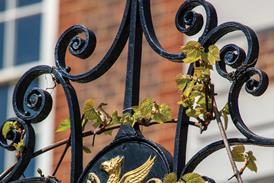Intendance: survey reveals best Web sites among the UK's top 50 fastest-growing legal practices
Regional law firm Shoosmiths has the best Web site of the UK's 50 fastest-growing law firms, according to research published this week.
It posted an overall score of 89% in the survey conducted by Intendance, a Web site and on-line business applications company. City firm SJ Berwin came second with 87%, followed by national practice Irwin Mitchell, regional firm Cobbetts and Kent-based Cripps Harries Hall in joint third place with 86%.
Intendance audited the sites of the 50 fastest-growing firms by turnover according to three key criteria: content, design and usability.
High scores for content were awarded to sites that provided comprehensive information about the firm, partners, practice areas, recruitment, and up-to-date information about news, events and seminars. Cobbetts, Shoosmiths and Bristol firm TLT headed this category, scoring 91%, followed by Irwin Mitchell with 89% and Cripps Harries Hall with 88%.
Top marks for design - how effectively the information is presented - went to Scottish firm Maclay Murray & Spens, which scored an impressive 96%. This category looked at fundamentals such as clarity of text, colour and the use of images. London firm Farrer & Co came second with 93%, with City firm Berwin Leighton Paisner, Edinburgh-based Brodies and London firm Bircham Dyson Bell in joint third place with 92%.
Scores on usability - how easy it is to find information - were based on the site's profile on the Google search engine, the relative speed of file download, technical design of the navigation menus, the presence of a site map, minimum scrolling and the ability to print Web pages.
Brodies came top in this category, with 93%, followed by Shoosmiths, with 91%, and another Scottish firm, Shepherd & Wedderburn, with 87%.
Top-ranked Shoosmiths has 222 fee-earners and saw a 23% increase in turnover from 2003 to 2004, making it the seventh fastest-growing firm in the UK and the 13th largest by number of fee-earners.
Its Web site scored highly for its extensive content and good usability. It was also easy to navigate with a 'clear hierarchy of content' and use of 'dynamic menus and sub-menus'.
Design was its weak spot; it scored 84%, putting it in 24th place, due to poor use of screen space, which increased the need to scroll, and poor colour contrast between text and background.
SJ Berwin's site was thought to be strong on usability and design but weaker in content, although it was one of the few sites that offered multilingual content. The reviewers praised it for consistent positioning of the navigation menu bar, appropriate use of sub-options, and its clear 'home' link.
Irwin Mitchell, the largest firm in the highest-scoring sites, offered comprehensive information about the firm and its services, plus a range of on-line services including making a will and changing your name. Its design was considered slightly staid but consistent, and it maintained a good balance of menus, images and text.
Cobbetts achieved joint top position for content (91%), tenth position for usability (79%) and joint 16th place for design with 87%. Its homepage - showing a close image of a smiling child - was thought to be one of the most striking of all 50 firms.
If the site had included a downloadable corporate brochure, reference to the firm's VAT number and more bilingual content, it would have achieved a perfect score for content.
Meanwhile, Kent-based Cripps Harries Hall received particular credit for its staff intranet and extranet content offered to registered visitors. It was rated very usable and rich in content but its design was dated and cluttered.
James Tuke, Intendance's client relationship director, commented: 'The best solicitors' Web sites serve existing clients well, help to attract new clients and can act as an excellent recruitment vehicle. Those firms without an effective Web presence are losing an unprecedented opportunity to present themselves on-line and compete with their peers.'
He said the results revealed almost no correlation between site excellence and the rate of increase in turnover or number of fee-earners. 'It is not how much money you spend on your Web site that determines success on the Internet, it's how well you spend it,' Mr Tuke added.
June Smallwood-Rose, marketing director at Shoosmiths, said: 'We think our Web site is user-friendly and accessible, but it can be improved. We are reviewing how well it meets the needs of our users. We want to make it quicker and easier to use and improve its look and feel.'
David Sanders, marketing director at Maclay Murray & Spens, said: 'Our Web site does not stand alone; it is an important part of our company branding. We wanted to give a feel of the firm's personality and show that everyone in the team is important.'
A questionnaire, completed by 25 of the firms, revealed site construction costs typically range from £10,000 to £25,000, and annual site maintenance budgets are between £5,000 and £20,000. It also found that law firm management tends to be 'hands-off', with sites discussed at board level only 'to some extent'. No firm claimed that the site was discussed 'often and in detail' at that level.
Intendance pointed out that the scoring system is updated annually to respond to the increasingly high standards demanded by site users, and advised readers not to make direct comparisons with scores in last year's survey. Its previous reviews also principally covered London-based firms.
The full report, which also contains a checklist to ensure an effective Web site, can be obtained
on-line at: www.intendance.com.
Charity Explorer provides a reputable reference tool for solicitors, will-writers and their clients who want to leave a legacy or charitable gift.
Visit Charity Explorer
Whether you are looking for legal expert witnesses, legal training/CPD providers, international law firms, administration of estates, legal software suppliers, barristers chambers or any other general legal service, the Legal Services Directory will provide a suitable option.
Visit Legal Services Directory

























No comments yet